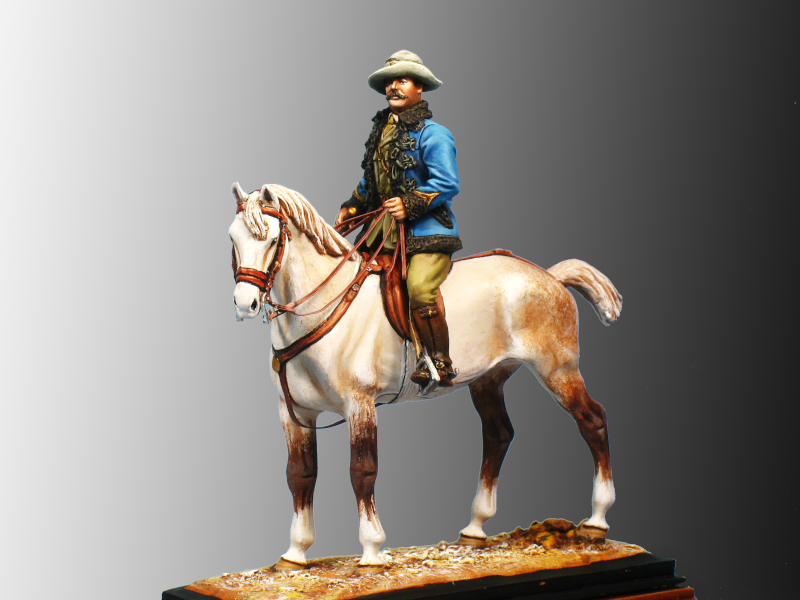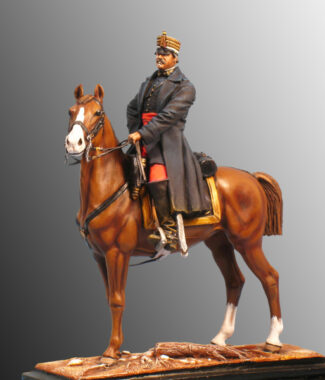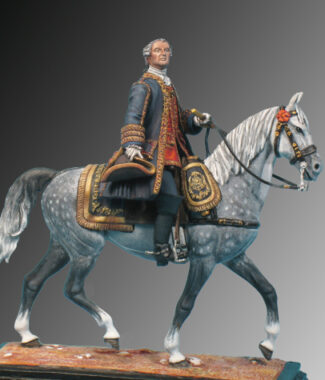You must be logged in to post a review.
Dámaso Berenguer – 1920
€89.00
Figure to assemble and paint
Ref.: 6 – PCA
Weight: 250 grs.
Material: White Metal
Number of Pieces: 18
Historical Review:
Dámaso Berenguer Fusté, 1st Count of Xauen (4 August 1873 – 19 May 1953) was a Spanish general and politician. He served as Prime Minister during the last rales of the reign of Alfonso XIII. Was born in San Juan de los Remedios, Cuba, while the island was a Spanish administrative division. He enlisted in the army in 1889, served in Cuba and Morocco.
He founded the Fuerzas Regulares Indígenas on 30 June 1911 and fought in the ensuing Kert campaign, leading the action that killed Riffian leader Mohamed Ameziane in 1912, bringing the end of the campaign. He was promoted to brigadier general in 1916, and, in 1918, to division general. In 1918, he was appointed Minister of War under Prime Minister Manuel García Prieto.
He was appointed January 1919 as High Commissioner of Spain in Morocco. He proceeded to occupy Xauen on 14 October 1920, and Berenguer, one of the leadings protected of Alfonso XIII in Africa along Manuel Fernández Silvestre, was granted the nobiliary title of Count of Xauen in reward.
The disaster for the Spanish Army in Morocco in the summer of 1921, which included the defeat at the Battle of Annual and the ensuing slaughter of about 2,000 Spanish soldiers in Monte Arruit, murdered by the Riffians after their surrender, delivered a coup de grâce to the regime of the Restoration. The Armed forces polarised to great lengths between africanistas vs. junteros. Berenguer sanctioned the deployment of chemical weapons against civilians during the Rif War, stating in a telegram communication directed to the War Minister in August 1921 that ” I have stubbornly resisted to the use of suffocating gases against these indigenous peoples but after what they have done, and of their treacherous and deceptive conduct, I have to use them with true joy.”
After three previous rejected attempts to hand in his resignation as High Commissioner, he finally did so by mid-1922. An official investigation carried out by General Picasso had been already opened to determine responsibilities for the disastrous military strategy vis-à-vis the 1921 collapse, and Berenguer, in his capacity as High Commissioner, was among those accused.
In the midst of the structural collapse of the Restoration regime, in the summer of 1923, conspiracy schemes were carried out in the army. In September the uprising of Miguel Primo de Rivera took place in Barcelona, bringing about the dictatorship that bears his name, as the king appointed the former as Prime Minister following the success of the coup d’état.
Despite attempts to bring the process to a halt by Primo de Rivera (he even attempted to confiscate the report), the trial on the performance of Berenguer and Navarro began on 16 June 1924. Attempting to pander to the military, Primo de Rivera amnestied Berenguer.
In 1926, Berenguer became Chief of Staff of the Military House of the King, a post conventionally destined to burn-out generals liked by Alfonso XIII in order to move them away from the spotlights for a time.
In January 1930, following the forced resignation of Primo de Rivera, Alfonso XIII tasked Berenguer with the formation of a government seeking to restore the country to its pre-1923 state, as it like nothing had happened in between. During his mandate as prime minister, Berenguer repealed some of the harsher measures introduced by Primo de Rivera, earning his regime the nickname “dictablanda” (the toothless dictatorship, blanda meaning soft, as opposed to the preceding “dictadura”, dura being the Spanish word for hard).
He also faced a number of problems, such as increasing demands for the abolition of the monarchy, disorganization among the country’s political parties after seven years of repression making the calling of prompt elections an impossible task, labour unrest, and at least one military uprising.
The figure is represented in the late 1920s -before the Annual disaster-, when Berenguer was High Commissioner of Morocco. He wears the khaki uniform, regulation for the entire Spanish army (Royal Order of June 20, 1914). He wears the open jacket with a tie, in use since that year. As can be seen from photographs of the period, it was common to combine the khaki uniform with the blue pelisse. In this case, he wears the slouch hat, widely used by Berenguer on campaign. He carries in his right hand the general’s baton, which has been obligatory for generals since the regulations of 1875.
The Price is not inclusive of shipping costs
5% for orders over 95,00€
10% for orders over 185,00 €
15% for orders over 275,00 €
- The discount fees are exclusively on items, without shipping costs -








Reviews
There are no reviews yet.